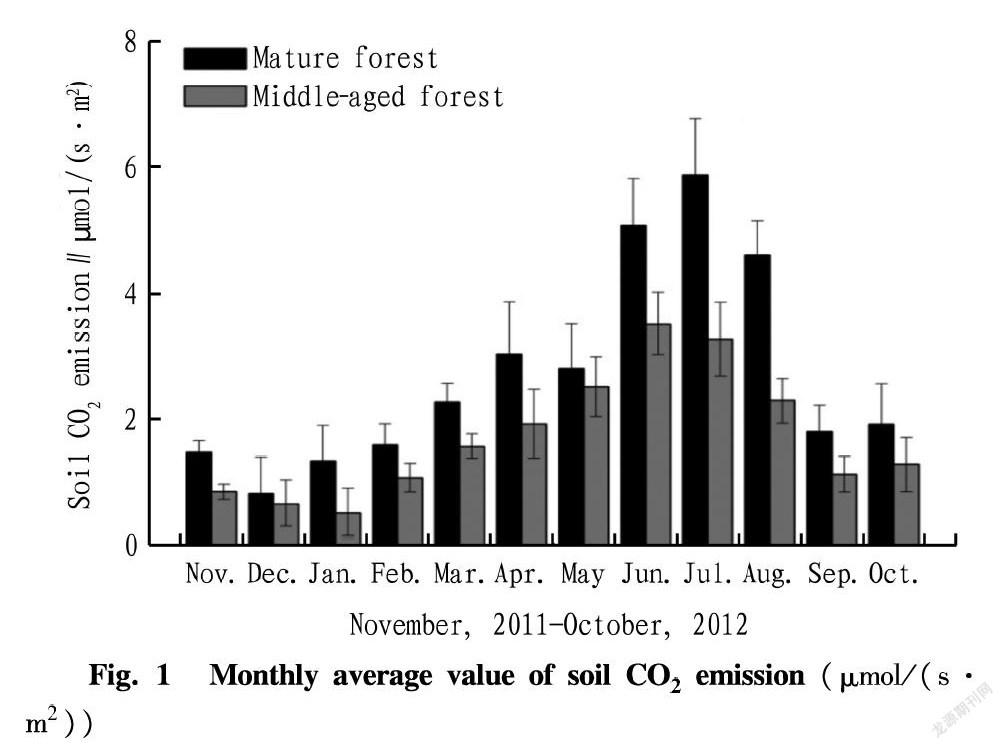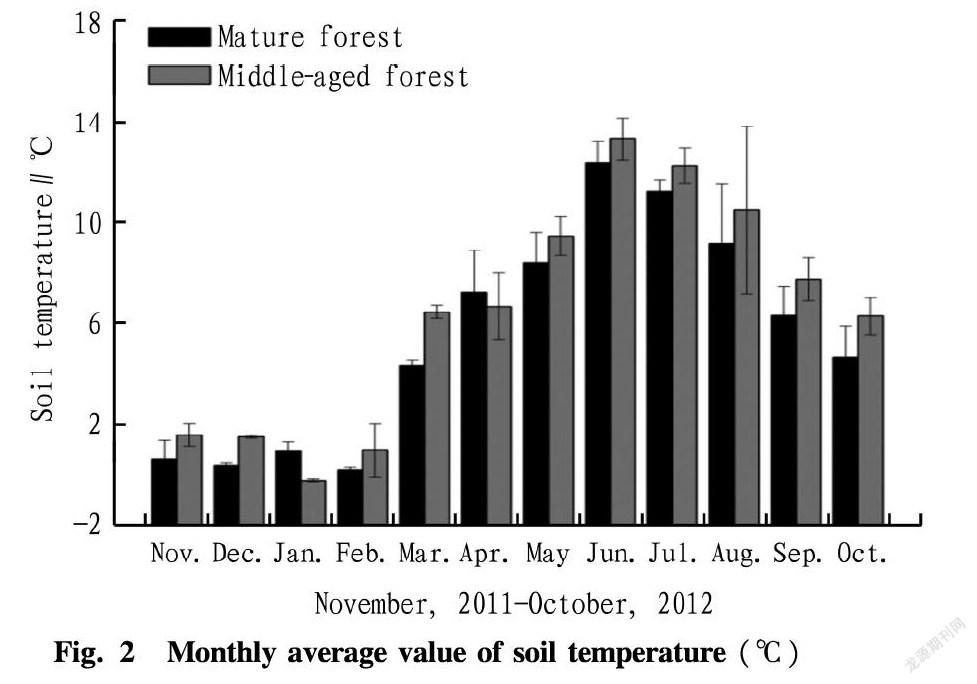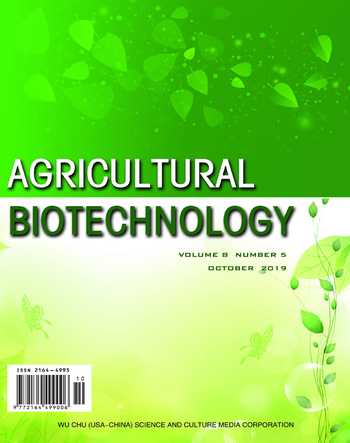CO2 Emissions from Soils in Subalpine Dark Coniferous Forest Region of Gongga Mountain
2019-09-10WeiLI1JiLUO1GuoqingJIADanliYANGYongmeiHE
Wei LI1 Ji LUO1 Guoqing JIA Danli YANG Yongmei HE




Abstract A field experiment was carried out to examine the soil respiration rate in Abies fabri forests in Gongga Mountain National Nature Reserve using LI-6400-09 portable soil respiration chamber. The results showed that the soil respiration rate and soil temperature of mature and middle-aged A. fabri forests were different in each month. The soil CO2 emission rates of the two stands had obvious seasonal variation characteristics, which were arranged: summer > autumn > spring > winter; the monthly average soil CO2 emission rate of the mature aged forest ranged from 0.82 to 5.88 μmol/(s·m2), with the coefficient of seasonal variation of 50.6%; and the average monthly soil respiration rate of middle-aged forest was in the range of 0.52-3.52 μmol/(s·m2), with the coefficient of seasonal variation of 48.5%. The seasonal variation of soil CO2 emission rate was positively correlated with the 5 cm soil temperature. And the Q10 values of the soil CO2 emission rates in the mature and middle-aged A. fabri forests were 3.2 and 2.6, respectively, and the sensitivity index of CO2 emission to temperature in the mature A. fabri forest was higher than that in the middle-aged forest.
Key words Abies fabri forest; CO2 emission; Coefficient of variation; Q10; Subalpine
In terrestrial ecosystems, soils accumulate large amounts of carbon[1], of which the carbon storage of forest soil is about 73% of the global soil carbon storage[2]. The amount of CO2 emitted by the soil as the second largest carbon flux after gross primary productivity (GPP)[3]is a key ecological process in the global carbon cycle. Due to its huge flux, small change in soil CO2 emission rate can have a significant impact on atmospheric CO2 concentration[4]. Global climate change has become a hot issue of concern to all mankind. As the main export mode of soil carbon and the important "carbon source" of the atmosphere, its accurate and systematic measurement has become a key issue in global climate change research. Due to the complexity of the soil itself and the diversity of its use, the current role of forest soil as an atmospheric CO2 source/sink cannot be accurately quantified, and the existing theories are mostly qualitative reasoning analysis. In some global carbon balance estimation studies, different authors use different assumptions, and some assumptions and some observations are contradictory, resulting in large differences between the estimates by different authors. Only by clarifying the carbon emission of forest soil can we accurately estimate the global carbon balance. In this study, through the annual positioning observation of soil CO2 emissions in mature and middle-aged Abies fabri forests of Gongga Mountain, forest soilsCO2 emissions and laws in the forests of different ages were investigated. This study will provide basic data for accurate estimation of carbon balance in A. fabri forest ecosystem and estimation of Chinas greenhouse gas inventory and forest carbon balance.
General Situation of Research Area
The mountainous areas in southwestern China are concentrated distribution areas of subalpine dark coniferous forests. Subalpine dark coniferous forests are a unique vegetation type in the low-latitude and high-altitude mountainous areas in southwestern China. The constructive species are mainly Picea and Abies species. Subalpine dark coniferous forests belong to the cold-temperate coniferous forests, and include many types and rich layers. They are obviously different from the zonal vegetation "Taiga" in community composition and structure, and the forest soils have no strong ashing effect. Abies is the more primitive genus of Picea which is adaptive to cold and wet environmental conditions and requires higher moisture. Abies species have higher vertical distribution than most Picea species, and are often the main constructive species of the upper part of the dark coniferous forest belt. The eastern margin of the Qinghai-Tibet Plateau usually presents the main tree species that constitute the forest line. A. fabri forests are a unique type of forest in Sichuan Province, mainly distributed along the western margin of the basin.
A. fabri forests are mainly distributed at the eastern slope of Gongga Mountain with the altitude of 2 800-3 600 m. At the altitude of 3 600 m, the forest line community is formed by A. fabri forests, which have a large vertical distribution range with high biomass and productivity, and are the main component of the subalpine dark coniferous forests. With the increase of altitude, the stand structure and understory composition of A. fabri forests change significantly. The experiment was carried out in the Gongga Mountain National Nature Reserve. Various vertical forest stands are well protected, and the areas with an altitude near 3 000 m are suitable distribution areas for A. fabri forests.
Research Methods
On the basis of comprehensively measuring the CO2 emission from the subalpine dark coniferous forests in Gongga Mountain, the mature and middle-age A. fabri forests with an altitude near 3 000 m were selected for simultaneous observation. Three observation points were set in each plot for the repeated observation of relevant meteorological factors such as atmospheric humidity, temperature, near-surface air temperature (air temperature 30 cm above the ground surface), surface temperature, and ground temperatures at 5 and 10 cm, and the soil samples of 0-10 cm in the surface layer were used to determine soil water content and bulk density. The CO2 emission rate was measured with a dynamic closed air chamber infrared CO2 analyzer (Li-6400-9) in parallel in different seasons. The leaf area index of the community, the net photosynthetic rate of the community and the respiration rate of the aboveground part of the plant were also determined by a laser leaf area meter (CI-203) and a plant canopy analyzer (CI-203) every year, and the biomass of the community and the soil constituents were investigated as well.
Results and Analysis
Seasonal variation of soil CO2 emissions
The CO2 in the soil mainly comes from surface litter, soil microbes, plant roots, soil animals and other components and the CO2 emitted by these components will have strong seasonal variation with the seasonal changes of external factors such as soil temperature.
It can be seen from Fig. 1 that the CO2 emissions of the mature and middle-age A. fabri forests had a certain seasonal variation law, that is, the soil CO2 emission was higher in the growing season (May-October) and lower in the non-growing season (November-next April). The coefficient of seasonal variation (CV) of the soil CO2 emission from the mature forest was 50.6%; and the smallest monthly average value of emission was in December, which was 0.82 μmol/(s·m2), and the largest monthly average value appeared in July, which was 5.88 μmol/(s·m2). The coefficient of seasonal variation of the soil CO2 emission in the middle-aged forest was 48.5%; and the smallest monthly average value was in January, which was 0.52 μmol/(s·m2), and the largest monthly average value was in June, which was 3.52 μmol/(s·m2).
The seasonal variation of soil temperature and the seasonal variation trend of soil CO2 were similar (Fig. 2). The seasonal variation coefficient of soil temperature in the mature forest was 56.0%; and the smallest monthly average value of soil temperature appeared in February, which was 0.2 ℃, and the largest monthly average value appeared in June, which was 12.3 ℃. The seasonal variation coefficient of soil temperature in the middle-aged forest was 49.1%; and the smallest monthly average value appeared in January, which was -0.3 ℃, and the largest monthly average value appeared in June, which was 13.3 ℃.
Sensitivity index of soil CO2 emission to temperature
There are many factors affecting soil CO2 emission, including the effects of soil physical and chemical properties, environmental factors such as temperature and precipitation, as well as other factors such as land interference and litter conditions, and other factors that affect soil CO2 emission may change with exact time and location[5]. Many studies have shown that temperature is often a major factor affecting soil CO2 emission, especially in areas with a humid climate[6]. Soil temperature is an important ecological factor limiting soil microbes and litter decomposition, plant root activity and plant growth and photosynthesis[7], while soil CO2 emission is closely related to soil microbes and plant root activity and plant growth. The relationship between soil CO2 emission and soil temperature is often described by the following exponential equation:
Rs=αexp(βT)
Wherein Rs represents soil CO2 emission rate; T represents soil temperature; and α and β are coefficients.
It can be seen from Fig. 3 that there was a significant positive correlation between soil CO2 emission rate and 5 cm soil temperature in the mature and middle-aged forests (P<0.001). The relationship between soil CO2 emission rate and 5 cm soil temperature of the mature forest was Rs=1.27e0.115 t, and the relationship between CO2 emission rate and 5 cm soil temperature of the middle-age forest soil was Rs=0.9e0.097 t. The exponential model based on soil temperature can account for 66% and 60% of the variation in soil CO2 emission rate in the mature and middle-aged forests, respectively.
Agricultural Biotechnology2019
In addition, Q10 is often used to describe the sensitivity of soil CO2 emission rate to temperature[8]:
Q10=exp(10β)
The Q10 value indicates the extent to which soil CO2 emissions change for every 10 ℃ increase in temperature. A larger Q10 value means that the soil CO2 emission is more sensitive to temperature change. According to calculation, the Q10 values of soil CO2 emission in the mature and middle-aged forests of Gongga Mountain in Shandong Province were 3.2 and 2.6, respectively. According to calculation, the Q10 values of soil CO2 emission in the mature and middle-aged forests of Gongga Mountain in Shandong Province were 3.2 and 2.6, respectively. This indicates that if the 5 cm soil temperature increases by 10 ℃, the CO2 emission rate of the mature A. fabri forest will increase by 320%, and the CO2 emission rate of the middle-aged A. fabri will increase by 260%. The soil CO2 emission of the mature forest was more sensitive to temperature change.
Soil CO2 emission flux in A. fabri forests
The average value of soil CO2 emission rate measured in middle ten days of each month represented the average soil CO2 emission rate this month. The monthly mean was multiplied by time to obtain soil CO2 emission per month (t C/hm2), and finally, the monthly average values were summed up to obtain the annual total amounts of CO2 emission from the mature and middle-aged forests at the eastern slope of Gongga Mountain (Table 1).
It can be seen from Table 1 that the annual soil CO2 emission of the mature forest was 10.33 t C/hm2. The monthly average soil CO2 emission was the largest in July, which was 1.89 t C/hm2, accounting for 18.3% of the total annual emission, followed by June, which was 1.58 t C/hm2, accounting for 15.3% of the total annual emission, and the lowest in December, only accounting for only 2.6% of the total annual emission. The annual soil CO2 emission in the middle-aged forest was 6.52 t C/hm2. The monthly average soil CO2 emission was the largest in June, followed by July, accounting for 10.6% and 10.2% of the total annual emission, respectively. It was the smallest in January, only accounting for 1.6% of the total. The total annual CO2 emission of the mature A. fabri forest was 58.6% higher than that of the middle-aged forest.
Conclusions and Discussion
The coefficient of seasonal variation (CV) of the soil CO2 emission from the mature forest was 50.6%; and the smallest monthly average value of emission was in December, which was 0.82 μmol/(s·m2), and the largest monthly average value appeared in July, which was 5.88 μmol/(s·m2). The seasonal coefficient of variation of the soil CO2 emission in the middle-aged forest was 48.5%; and the smallest monthly average value was in January, which was 0.52 μmol/(s·m2), and the largest monthly average value was in June, which was 3.52 μmol/(s·m2).
The relationship between soil CO2 emission rate and 5 cm soil temperature in the mature forest was Rs=1.27e0.115 t, and the relationship between CO2 emission rate and 5 cm soil temperature in the middle-age forest soil was Rs=0.9e0.097 t. The soil temperature-based exponential model can account for 66% and 60% of the variation in soil CO2 emission rate in the mature and middle-aged A. fabri forests, respectively. The Q10 values of soil CO2 emission in the mature and middle-aged A. fabri forests of Gongga Mountain in Shandong Province were 3.2 and 2.6, respectively. The CO2 emission intensities of the two types of soils and the differences in
different seasons reflected that their respective responses to season change were different.
The annual soil CO2 emission of the mature forest was 10.33 t C/hm2. The monthly average soil CO2 emission was the largest in July, followed by June, and the smallest in December. The annual soil CO2 emission in the middle-aged forest was 6.52 t C/hm2. The monthly average soil CO2 emission was the largest in June, followed by July, and the smallest in January. The total annual CO2 emission of the mature A. fabri forest was 58.6% higher than that of the middle-aged forest.
The soil CO2 emission rate of the community had obvious seasonal variation characteristics, and exhibited an order of summer > autumn > spring > winter. The seasonal variation of soil CO2 emission rate in the two forests had a strong positive correlation with the 5 cm soil temperature. The sensitivity index (Q10 value) of soil CO2 emission to temperature in the mature forest was significantly higher than that in the middle-aged forest. It indicates that in the future global warming process, the soil CO2 emission rate of the mature forest will increase more rapidly.
Accurately determining the dynamic change of soil CO2 emission in different succession stages can help to grasp a major aspect of carbon dynamics during vegetation restoration, and has important reference significance for vegetation restoration and reconstruction. It is also an important part of monitoring the ecological environment changes of nature reserves and studying the process of forest carbon cycle[9], and is also of great significance for accurately estimating the greenhouse gas emissions of subalpine dark coniferous forests and their responses to climate change.
References
[1]DIXON RK, BROWN S, HOUGHTON RA, et al. Carbon pools and flux of global forest ecosystems[J]. Science, 1994, 263(5144): 185-190.
[2]BROWN S, LUGO AE. The storage and production of organic-matter in tropical forests and their role in the global carbon-cycle[J]. Biotropica, 1982, 14(3): 161-187.
[3]RAICH JW, SCHLESINGER WH. The global carbon dioxide flux in soil respiration and its relationship to vegetation and climate[J]. Tellus Series B-Chemical and Physical Meteorology, 1992, 44: 81-99.
[4]RUSTAD L, HUNTINGTON T, BOONE R. Controls on soil respiration: Implications for climate change[J]. Biogeochemistry, 2000, 48: 1-6.
[5]RAICH JW, TUFEKCIOGLU A. Vegetation and soil respiration: Correlations and controls [J]. Biogeochemistry, 2000, 48(1): 71-90.
[6]ZHENG ZM, YU GR, FU YL, et al. Temperature sensitivity of soil respiration is affected by prevailing climatic conditions and soil organic carbon content: A trans-china based case study[J]. Soil Biology & Biochemistry, 2009, 41(7): 1531-1540.
[7]CHEN QS, LI LH, HAN XG, et al. Temperature sensitivity of soil respiration in relation to soil moisture in 11 communities of typical temperate steppe in Inner Mongolia[J]. Acta Ecologica Sinica, 2004, 24(4): 831-836. (in Chinese)
[8]RUSTAD LE, HUNTINGTON TG, BOONE RD. Controls on soil respiration: Implications for climate change[J]. Biogeochemistry, 2000, 48(1): 1-6.
[9]KRISTI P, KAJAR K, KALEV J, et al. Impact of post-fire management on soil respiration, carbon and nitrogen content in a managed hemiboreal forest[J]. Journal of Environmental Management, 2019, 233(1): 371-377.
杂志排行
农业生物技术(英文版)的其它文章
- Study on Quality Evaluation and Standards of the Zhuang Medicine Pandanus tectorius Soland.
- Mechanism of Apoptosis Induced by Scopoletin in Breast Cancer Cells
- Research Progress of Low Temperature Preservation Technology for Aquatic Products
- Optimization on Ultrasonic Extraction Method of Total Flavonoids for Liriodendron chinense Sarg.×L. tulipifera L. by Response Surface Methodology (RSM)
- Study on Characteristic Fingerprint of Chemical Constituents in the Pholidota cantonensis Rolfe.
- Discussion on Operation Risk and Management of Food Inspection Organizations
